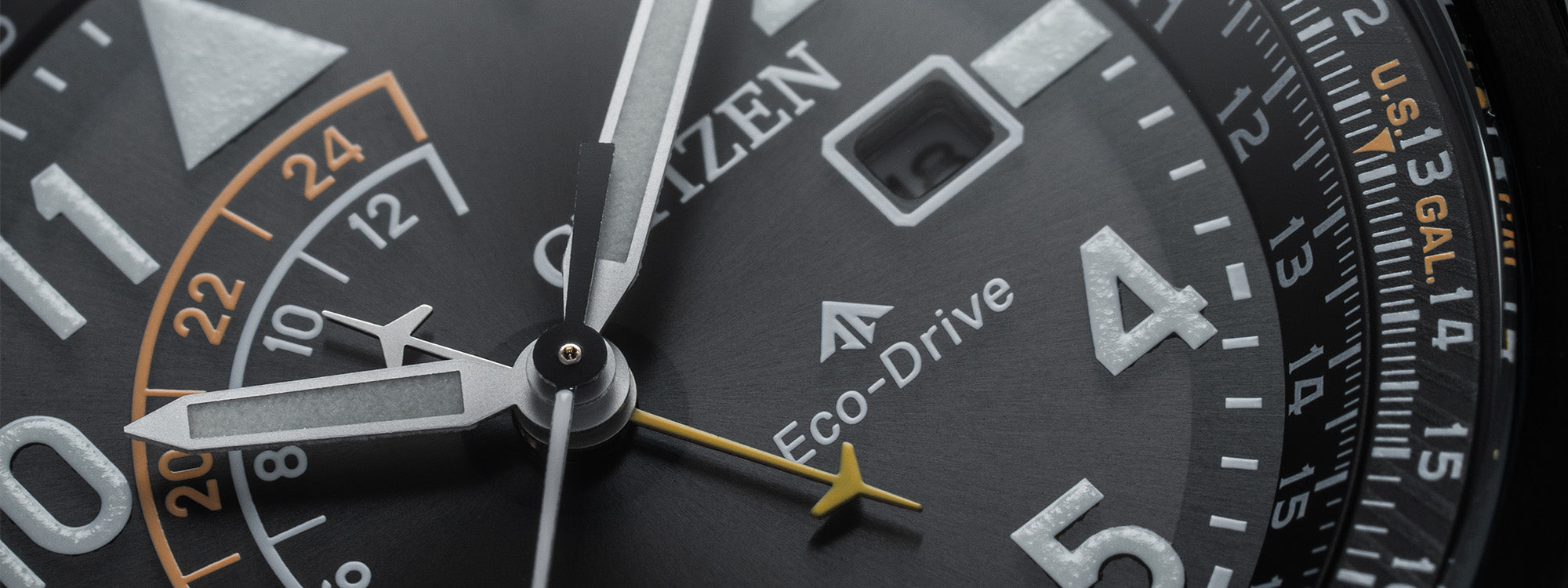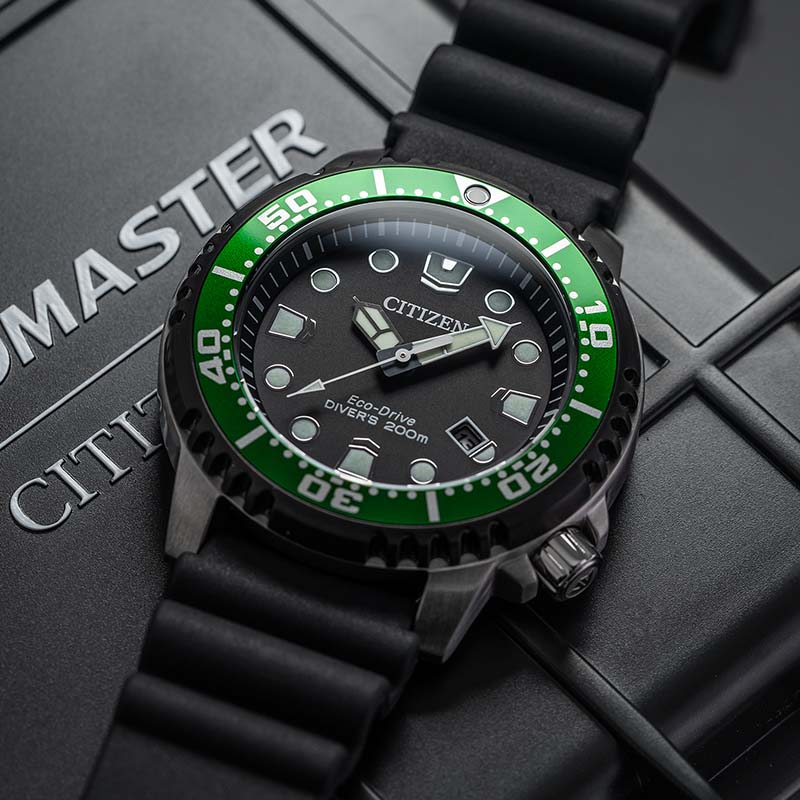The history of the watch industry is rife with groundbreaking technological developments that came about through necessity. Dive watches’ unidirectional rotating bezels were developed to save the lives of scuba divers by ensuring they wouldn’t misread their time underwater and inadvertently run out of oxygen. Luminous paint on watch dials was invented so wearers could read the time in the dark or underwater. Antimagnetic innovations in watch movements came about as everyday life in the 20th century exposed us to more and more electromagnetic fields that affected our watches’ efficient running. One of the more recent examples is Citizen’s now-famous and still-exclusive Eco-Drive movement — which emerged as a direct result of the worldwide energy crisis that galvanized environmentalists in the 1970s.

Citizen pocket watch from 1924
Citizen, like all watch companies that trace their history back to the early 20th Century, was a traditional watchmaker long before it became an innovator in high-tech, electronic timekeeping — founded in 1918 in Japan, as the Shokosha Watch Research Institute. The name “Citizen” first appeared on one of the company’s pocket watches in 1924, an indication that Shokosha, which officially became Citizen Watch Company in 1930, would be devoted to making timepieces that were accessible to “all citizens” of Japan, and eventually, of the world. By the 1970s — with several milestones under its belt, including the first calendar watch and first waterproof watch made in Japan — Citizen had become one of the first fully automated watch companies and, like many of its competitors at the time, was fully engaged in the pursuit of making watches to appeal to a new generation of customers — watches with battery-powered movements, rather than mechanical ones, that would be both inexpensive to produce and far more accurate than what had come before.
The quest had begun as early as 1957, when American watchmaker Hamilton produced the first electronic watch, the Ventura, and continued into the 1960s, with another U.S.A.-based watchmaker, Bulova, adding its own milestone invention, the tuning-fork-driven Accutron. The only technology that proved to have staying power, however, was the one that debuted in 1969’s Quartz Astron, made by Citizen’s Japanese rival, Seiko — a battery-powered movement that used an electrically charged, fast-vibrating quartz crystal rather than a traditional gear train to drive the hands of the watch, for a never-before-seen accuracy of -5/+5 seconds per month. Quartz movements became the dominant technology in watchmaking for the next decade and more, and remain popular today for the same reasons they very nearly swept away their old-school mechanical counterparts back in the 1970s and ‘80s: quartz-powered watches are more accurate, more shock-resistant, and more affordable than mechanical ones.

Gasoline shortages led to long lines in the 1970s Energy Crisis.
One issue with quartz calibers remained vexing, however (other than their being looked down upon by mechanical-watch purists) — the fact that they needed regular battery changes to keep working in the long term and thus, generated chemical waste when those spent batteries ended up in landfills. Fuel shortages and skyrocketing energy prices in the 1970s, prompted by an international embargo on petroleum products by the Arab oil exporting countries of OPEC, was also a factor, as it not only led to the infamous gas-station lines pictured above, but also forced a renewed interest in non-fossil fuel energy sources such as solar power. Citizen, which made its first quartz watch in 1973, set out to solve the problem with some clever innovating of its own that centered around harnessing the power of sunlight.

The origin of Eco-Drive, Citizen’s most influential and well-known technical contribution to watch history, begins in 1976, with the introduction of the Quartz Crystron Solar Cell (above), the first watch with a quartz movement whose rechargeable battery was under a photovoltaic solar panel that could absorb energy from any light source — from natural sunlight to a lamp on a nightstand. This so-called “Sunwatch,” which was notable for its grid of four solar cells extending radially from the center, was the first light-powered analog wristwatch, but its battery life was very low — it generally needed recharging once a week — so Citizen continued upgrading the light-charging technology.
In 1986, upon successfully developing thinner solar cells to generate energy and stronger batteries to store it, Citizen released another “solar cell” watch that could run on a single charge of light for eight days, or 200 hours. The next step in the technology’s evolution was in 1995, when Citizen added a lithium-ion power cell that extended the watch’s running time to six full months on a single charge.

The first Citizen Eco-Drive watches, powered by the Caliber 7878, were launched one year after this breakthrough, in 1996. They were equipped with the groundbreaking technology that is still at the heart of the Eco-Drive movements today: light passes through a translucent dial with an amorphous silicon photocell mounted directly underneath it, which supplies power to the lithium ion battery of the movement below. From an environmental standpoint, this also means the wearer almost never needs to discard old batteries and replace them with new ones. The first generation of Eco-Drive watches were simple three-hand timekeepers with dates, but as the technology improved, future iterations included a wide range of complications and styles, including chronographs, perpetual calendars, analog-digital displays and, beginning in 1998 with the Promaster Eco-Duo Drive, dive watches.

Many Citizen dive watches, like the Promaster Diver "Orca" still use Eco-Drive calibers.
During the late 1990s, Citizen experimented with other variations on the Eco-Drive system, as in the Eco-Drive Thermo watches that surfaced in 1999, which used the “Thermo electricity” generated by the temperature difference between the wearer’s arm and his surroundings, to power the movement. Another version, which was used in the aforementioned Promaster dive watch, was the Hybrid Eco-Drive movement that used both mechanical parts and a solar cell to charge the watch’s functions. Both of these offshoots have since been discontinued, and the core light-powered Citizen Eco-Drive movement has become the tentpole technology around which Citizen has built much of its modern collection — even as Citizen has continued to improve upon it. By the early 2000s, for example, the company developed smaller, ring-shaped solar cells that eliminated the need for transparent dial materials and opened up new design possibilities for the dials (see below).

In the 21st century, Citizen has taken its emblematic light-powered technology to new levels of precision, first with the integration of radio-controlled timing technology into its Eco-Drive calibers in 2002. Introduced into watchmaking by the German brand Junghans in 1990, and first used by Citizen in a watch as early as 1993, radio-controlled timekeeping works by regularly synching a watch’s electronic movement with a transmitter from one of the world’s ultra-precise atomic clocks, ensuring a precision of just one second’s error per 100,000 years. In theory, radio-controlled Eco-Drive watches will never need battery changes or manual resetting — just regular exposure to sunlight and atmospheric radio waves.

Citizen ventured into smartwatch territory with the Eco-Drive Proximity in 2012.
In 2011, Citizen launched the first Eco-Drive GPS Satellite Wave watches, which received time synchronization signals from Global Positioning System (GPS) satellites to automatically update their time and date anywhere in the world. One year later, in 2012, came the Citizen Eco-Drive Proximity, what we would today call a Smartwatch, which connected to an Apple iPhone for an array of functions, including alerts for incoming calls, texts, and email messages.

Eco-Drive turned 40 years old in 2016, and Citizen marked the anniversary with the launch of a new watch called Eco-Drive One (above), which at the time of its release was the thinnest light-powered analog watch in the world. Its case, made of a ceramic composite material called cermet, is 38.15mm in diameter and just 2.98 mm thick, with a bezel made of cemented carbide, a material boasting extreme hardness as well as high corrosion- and oxidation-resistance. Its Eco-Drive movement, which Citizen says required a total redesign of the original, comes in at just 1.00 mm thick and still claims an accuracy of +/-15 seconds per month. The movement also consumed less energy than its thicker predecessors, enabling the watch to run for 10 months on a single full charge from any light source.

Citizen's Caliber 0100 is the most accurate Eco-Drive movement ever made.
The most significant advance came in 2019, with the introduction of Caliber 0100, an Eco-Drive movement that calibrates time to an astonishing accuracy of +/- 1 second per year. The watch that contains it is the current record holder for the title of “world’s most accurate watch.” Caliber 0100 achieves this unprecedented feat without relying on synchronized data from satellites or radio-controlled clocks. Instead, Citizen equipped the caliber with new AT-cut-type crystal oscillators, which vibrate at a frequency of 8.4 MHz, in place of the tuning fork-shaped oscillators used in most quartz movements. The former’s frequency is more than 250 times higher than the latter’s. Citizen also devised clever power-saving strategies for the movement while also ensuring the entire mechanism is resistant to outside influences such as temperature variations, gravity, and age degradation. The result is dependably stable operation for up to six months on a single light charge, or eight months in its power-save mode. The watch will even automatically correct the hand positions after it is subjected to shocks. As the move toward sustainable energy sources continues to accelerate around the world, Citizen Eco-Drive watches remain on the cutting edge of technology.






















































3 Comments
Citizen Eco Drive watches are brilliant. I own 2 and I sometimes debate which one to wear during the day.
Can’t wait till the 50th anniversary edition in ’26.
Eco Drive watches by Citizen are my favorite watch.